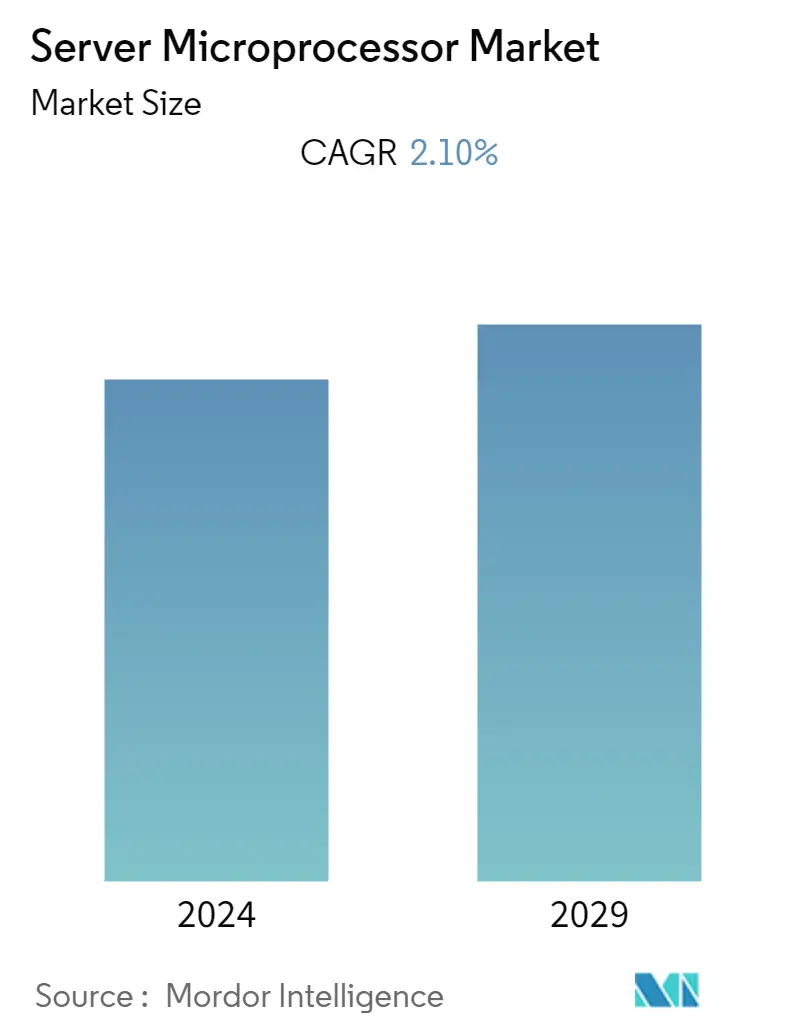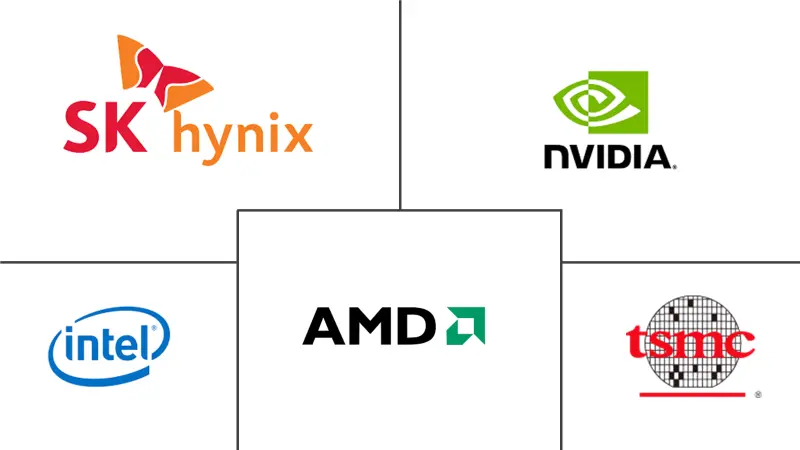Market Size of Server Microprocessor Industry

| Study Period | 2021 - 2029 |
| Base Year For Estimation | 2023 |
| CAGR | 2.10 % |
| Fastest Growing Market | Asia-Pacific |
| Largest Market | North America |
| Market Concentration | Low |
Major Players
*Disclaimer: Major Players sorted in no particular order |
Server Microprocessor Market Analysis
The server microprocessor market is expected to register a CAGR of 2.1% over the forecast period. They are increasing their data center footprint, and demand from cloud service providers prompts the growth of the server microprocessor market. Dominated by the duopoly of Intel and AMD, the market for server microprocessors is undergoing product innovations. Companies realize the performance needs for modern workloads such as data analytics, machine learning, and artificial intelligence and are improving their designs accordingly.
- The server microprocessors are bound to rapid technological change, which results in challenging quality adjustments for the companies. Some of the significant characteristics for measuring the quality of microprocessors include cores, threads, base frequency, turbo frequency, cache size, and thermal design power. Power consumption and performance are expected to remain the focus for microprocessors over the forecast period.
- According to the Consumer Technology Association (CTA), retail sales revenue for the consumer technology industry in the United States was forecasted to reach a record-breaking USD 487 billion in the previous year-a 7.5% increase compared to the previous years. A similar trend has been observed in other countries as well. The rapidly expanding demand for smartphones, tablets, and other smart home devices is among the major factors driving the demand for microprocessors, as microprocessors optimize the performance of these devices by improving speed and efficiency.
- Apart from this, the increasing penetration of smart home products also drives the demand for microprocessors. Devices like smart locks, fire and smoke alarm systems, smart speakers, etc. are increasingly taking their place in people's lives. Coupled with the increasing spending capacity of the middle class, especially across developing countries such as India and Brazil, this is expected to support further market growth.
- The growth of big data analytics and cloud computing, as well as the expansion of mobile broadband, drive the demand for new data center infrastructures.According to Cloudscene, North America alone (US and Canada) houses around 3029 data centers as of this year, making it a prominent market for server microprocessors.
- Furthermore, the rapid rise of the Internet of Things is one significant reason for promoting microprocessor usage (IoT). IoT technologies enable microprocessors because it is now technically and economically feasible to collect data from a far wider range of things than was previously conceivable. Companies frequently misjudge the complexity and volume of data generated by IoT products and platforms, necessitating the deployment of solutions to help them manage and interpret all of the data they are now collecting.
- The global outbreak of COVID-19 had a mixed impact on the worldwide microprocessor market. While the widespread lockdown across various countries significantly disrupted microprocessor manufacturers' supply chains and manufacturing capabilities, the demand for these semiconductor devices increased substantially across the healthcare and consumer electronics sectors.
The server microprocessor market is expected to register a CAGR of 2.1% over the forecast period. They are increasing their data center footprint, and demand from cloud service providers prompts the growth of the server microprocessor market. Dominated by the duopoly of Intel and AMD, the market for server microprocessors is undergoing product innovations. Companies realize the performance needs for modern workloads such as data analytics, machine learning, and artificial intelligence and are improving their designs accordingly. - The server microprocessors are bound to rapid technological change, which results in challenging quality adjustments for the companies. Some of the significant characteristics for measuring the quality of microprocessors include cores, threads, base frequency, turbo frequency, cache size, and thermal design power. Over the next few years, microprocessors will likely continue to focus on how much power they use and how well they work.
- According to the Consumer Technology Association (CTA), retail sales revenue for the consumer technology industry in the United States was forecasted to reach a record-breaking USD 487 billion in the previous year-a 7.5% increase compared to the previous years. A similar trend has been observed in other countries as well. The rapidly expanding demand for smartphones, tablets, and other smart home devices is among the major factors driving the demand for microprocessors, as microprocessors optimize the performance of these devices by improving speed and efficiency.
- Apart from this, the increasing penetration of smart home products also drives the demand for microprocessors. Devices like smart locks, fire and smoke alarm systems, smart speakers, etc. are increasingly taking their place in people's lives. Coupled with the increasing spending capacity of the middle class, especially across developing countries such as India and Brazil, this is expected to support further market growth.
- The growth of big data analytics and cloud computing, as well as the expansion of mobile broadband, drive the demand for new data center infrastructures.According to Cloudscene, North America alone (US and Canada) houses around 3029 data centers as of this year, making it a prominent market for server microprocessors.
- Furthermore, the rapid rise of the Internet of Things is one significant reason for promoting microprocessor usage (IoT). IoT technologies enable microprocessors because it is now technically and economically feasible to collect data from a far wider range of things than was previously conceivable. Companies frequently misjudge the complexity and volume of data generated by IoT products and platforms, necessitating the deployment of solutions to help them manage and interpret all of the data they are now collecting.
- The global outbreak of COVID-19 had a mixed impact on the worldwide microprocessor market. While the widespread lockdown across various countries significantly disrupted microprocessor manufacturers' supply chains and manufacturing capabilities, the demand for these semiconductor devices increased substantially across the healthcare and consumer electronics sectors.
Server Microprocessor Industry Segmentation
Microprocessor chips are silicon devices that serve as the central processing unit. Microprocessors used to process the analytical decision-making process on the servers (known as server microprocessors), used inside servers for data centers, are considered in the scope of the market. The study does not cover microprocessors for smartphones, autonomous vehicles, and other smart devices.
The server microprocessor market is segmented by type (APU, CPU, GPU, and FPGA), application (consumer electronics, enterprise computers and servers, automotive, and industrial), and geography (North America, Europe, Asia-Pacific, Latin America, and the Middle East and Africa).
The market sizes and forecasts are provided in terms of value (USD million) for all the above segments.
| By Type | |
| APU | |
| CPU | |
| GPU | |
| FPGA |
| By Application | |
| Consumer Electronics | |
| Enterprise - Computer and Servers | |
| Automotive | |
| Industrial | |
| Other Applications |
| By Geography | |
| North America | |
| Europe | |
| Asia-Pacific | |
| Latin America | |
| Middle East and Africa |
Server Microprocessor Market Size Summary
The server microprocessor market is experiencing growth driven by the expanding data center footprint and increasing demand from cloud service providers. This market is predominantly dominated by Intel and AMD, which are leading the way in product innovations to meet the performance requirements of modern workloads such as data analytics, machine learning, and artificial intelligence. The rapid technological advancements in microprocessors necessitate continuous quality adjustments, focusing on parameters like cores, threads, and power consumption. The market is also influenced by the growing demand for consumer electronics, smart home devices, and the proliferation of the Internet of Things (IoT), which require efficient microprocessors to enhance device performance and manage vast amounts of data.
The Asia-Pacific region is witnessing significant growth in the server microprocessor market, driven by the automotive industry's shift towards autonomous vehicles and the increasing demand for consumer electronics. The region's fast digitalization and high-tech gadget penetration, coupled with substantial IT investments and rising demand for cloud-based services, are expected to propel market growth. The server microprocessor market is characterized by intense competition, with Intel and AMD leading, while other players like SK Hynix Inc. and Nvidia Corporation also contribute to the market dynamics. Recent developments include new product launches and collaborations aimed at addressing the needs of next-generation data centers, highlighting the ongoing innovation and strategic partnerships within the industry.
Server Microprocessor Market Size - Table of Contents
-
1. MARKET DYNAMICS
-
1.1 Market Drivers
-
1.1.1 Increase in Demand for High-performance and Energy-efficient Processors
-
-
1.2 Market Restraints
-
1.2.1 Decrease in Demand for PCs
-
-
-
2. MARKET SEGMENTATION
-
2.1 By Type
-
2.1.1 APU
-
2.1.2 CPU
-
2.1.3 GPU
-
2.1.4 FPGA
-
-
2.2 By Application
-
2.2.1 Consumer Electronics
-
2.2.2 Enterprise - Computer and Servers
-
2.2.3 Automotive
-
2.2.4 Industrial
-
2.2.5 Other Applications
-
-
2.3 By Geography
-
2.3.1 North America
-
2.3.2 Europe
-
2.3.3 Asia-Pacific
-
2.3.4 Latin America
-
2.3.5 Middle East and Africa
-
-
Server Microprocessor Market Size FAQs
What is the current Server Microprocessor Market size?
The Server Microprocessor Market is projected to register a CAGR of 2.10% during the forecast period (2024-2029)
Who are the key players in Server Microprocessor Market?
Advanced Micro Devices, Inc., Intel Corporation, Marvell Technology Group(Cavium, Inc.), IBM Corporation and Oracle Corporation are the major companies operating in the Server Microprocessor Market.

